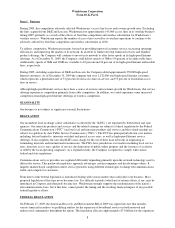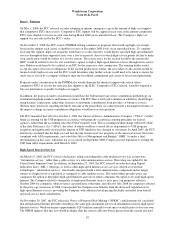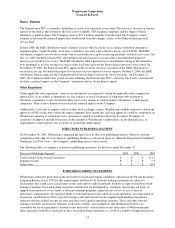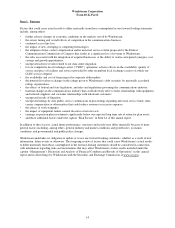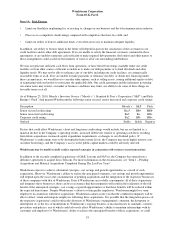Windstream 2009 Annual Report Download - page 83
Download and view the complete annual report
Please find page 83 of the 2009 Windstream annual report below. You can navigate through the pages in the report by either clicking on the pages listed below, or by using the keyword search tool below to find specific information within the annual report.
Windstream Corporation
Form 10-K, Part I
Item 1. Business
On May 1, 2008, the FCC released an order adopting an interim, emergency cap on the amount of high-cost support
that competitive ETCs may receive. Competitive ETC support will be capped in each state at the amount competitive
ETCs were eligible to receive in such state during March 2008 on an annualized basis. The Company’s high-cost
support was not affected by the FCC’s order.
On November 5, 2008, the FCC issued a FNPRM seeking comment on proposals that would cap high-cost receipts
based on the support each carrier is eligible to receive at December 2008 levels on an annualized basis. To continue
receiving this support, high-cost recipients would have to certify that they would deploy specified high-speed Internet
services throughout their supported areas over a five-year period. Areas for which high-cost recipients decline to make
such certification would be subject to a reverse auction. The reserve price for the auction would be the amount the
ILEC would be entitled to receive if it would have agreed to deploy high-speed Internet services throughout its service
area. Bidders would need to be certified as an ETC by the respective state commission. The winning bidder would
accept all carrier of last resort obligations. If the auction produced no winner, the area subject to the auction would be
deemed a truly high-cost area and the FCC would determine what further actions would need to be taken to ensure the
study area is served by a company willing to meet the broadband commitment and carrier of last resort requirements.
Proposals under consideration by the FNPRM also would eliminate the identical support rule, which allows
competitive ETCs to receive the same per line support as the ILEC. Competitive ETCs, instead, would be required to
file cost information to qualify for high-cost support.
In addition, the proposals under consideration would base the federal universal service contribution methodology on
residential telephone numbers and business revenues. The FCC then would seek comment on whether it should begin
using business connections, rather than revenues, to determine contributions from providers of business services.
Without more specificity regarding the likely outcome of the proceeding, we cannot provide a meaningful estimate of
the impact a change in carrier contribution obligations would have on our operations.
The FCC mandated that, effective October 1, 2004, the Universal Service Administrative Company (“USAC”) would
begin accounting for the USF program in accordance with generally accepted accounting principles for federal
agencies, rather than the accounting rules that USAC formerly used. This accounting method change subjected USAC
to the Anti-Deficiency Act (“ADA”), the effect of which could have caused delays in payments to USF program
recipients and significantly increased the amount of USF regulatory fees charged to consumers. In April 2005, the FCC
tentatively concluded that the high-cost and low-income universal service programs of the universal service fund were
compliant with ADA requirements, and asked the Office of Management and Budget (“OMB”) to make a final
determination on this issue, which has not yet occurred. In September 2008, Congress passed legislation to exempt the
USF from ADA requirements until March 6, 2009.
High-Speed Internet Services
On March 15, 2002, the FCC issued a declaratory ruling concluding that cable modem service was an interstate
“information service,” rather than a cable service or a telecommunications service. This ruling was upheld by the
United States Supreme Court. In addition, on September 23, 2005, the FCC released an order declaring Digital
Subscriber Line (“DSL”) offerings, as well as other high-speed Internet access services offered over wireline
technologies, “information services” functionally integrated with a telecommunications component and no longer
subject to a higher level of regulation as compared to cable modem service. The order further provides price cap
companies the option to deregulate high-speed Internet and rate-of-return companies the option to de-tariff high-speed
Internet. The Company elected to deregulate its high-speed Internet services in its price cap properties effective
October 2006 for companies subject to price cap regulation at that time, and effective July 2008 for companies affected
by the price cap conversion in 2008. Consequently the Company now benefits from the decreased regulation of its
high-speed Internet services, providing the Company with additional retail pricing flexibility and relief from federal
universal service fund contributions.
On November 20, 2007, the FCC released a Notice of Proposed Rule Making (“NPRM”), which tentatively concluded
that all high-speed Internet providers should pay the same pole attachment rate for all attachments used for high-speed
Internet services. Windstream pays approximately $28.0 million annually to rent space on utility poles it does not own.
The NPRM suggests that this rate should be higher than the current cable rate but no greater than the current rate paid
10










